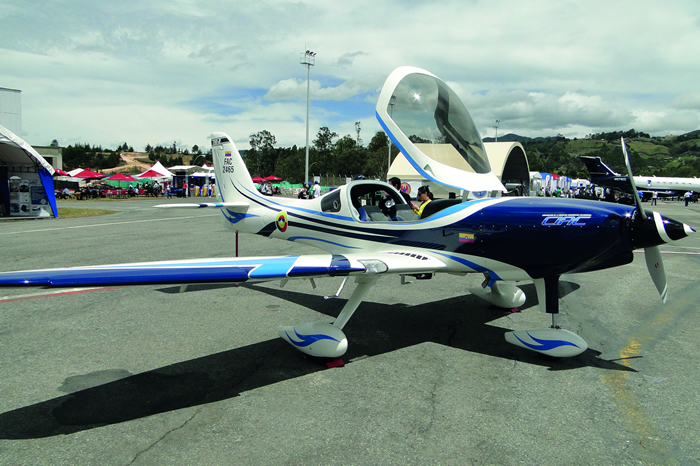Proposal to Reduce Temperature in the Aircraft Cabin of T90-Calima
DOI:
https://doi.org/10.18667/cienciaypoderaereo.190Keywords:
Aircraft, Cockpit, TemperatureAbstract
Temperature is important when performing an activity, if wind chill is not pleasant, a simple job can turn into a complicated job, exposing the integrity of the person. In training aircrafts, pilots are aware of the inconveniences of exposure to high temperature generated by solar radiation and equipment among others. By including a cooling system on the training cabin, the aircraft is affected by characteristics such as balance, increased fuel consumption and decreased efficiency due to increased weight. In this article, we present three ways to reduce the temperature in the cabin of the aircraft T-90 in the different phases of flight. They consist of implementing air inlets and outlets, using a heating film for the cabin and developing a device that allows air circulation in the pre-takeoff stage.
Downloads
References
M Company. (2012). Prestige Series 70. Retrieved from http://solutions.3m.com/wps/portal/3M/en_US/Window_Film/Solutions/Markets-Products/Residential/Sun_Control_Window_Films/Prestige_Series/
Acosta Palacios, F. E., & Cedeño Niño, N. F. (2015). Diseño del sistema de climatización de la cabina del avión de instrucción T-90C CALIMA. Escuela Militar de Aviación “Marco Fidel Suarez.”
Alvin H. Sacks, J. R. S. (1951). Theoretical investigation of submerged inlets at low speeds. Washington, DC, United States. Retrieved from http://naca.central.cranfield.ac.uk/reports/1951/naca-tn-2323.pdf
CIAC. (2015). Historia, Primara Aeronave. Retrieved February 19, 2015, from http://www.ciac.gov.co/productos-y-servicios/historia/141
Eastman Chemical Company. (2014). Huüper Optik Nano-Ceramic 70 Window Film. Retrieved from https://www.huperoptik.com/en/news/detail.aspx?t=1&id=27
Escuela Colombiana de Ingeniería. (2008). Curso de Higiene y Seguridad Industrial. Retrieved from http://www.escuelaing.edu.co/uploads/laboratorios/6299_temperatura.pdf
Establecimiento de sanidad militar (ESM). (2013). Informe de Mediciones Ambientales T-90. Santiago de Cali.
Evektor-Aerotechnik, A. . (2015). Cosmik EV-97. Retrieved July 13, 2015, from http://www.evektor.cz/
Frick, C. W., Davis, W. F., Randall, L., & Mossman, E. A. (1945). An Experimental Investigation of NACA Submerged-Duct Entrances. Washington, DC, United States. Retrieved from http://ntrs.nasa.gov/search.jsp?R=20090012113
Garmin Ltd. (2015). Garmin. Retrieved July 15, 2015, from http://www.garmin.com/en-GB
Instituto de Hidrología Meteorología y Estudio Ambientales. (2006). Atlas de radiación solar de Colombia. Retrieved from http://www.si3ea.gov.co/Home/EnergiaSolar/tabid/74/language/en-US/Default.aspx
Mancera Fernández, M. J. (2016). Temperatura. Retrieved January 22, 2015, from http://www.manceras.com.co/publicaciones.htm
Naval Aerospace Medical Institute. (1991). Flight Surgeon`s Manual tercera edición. (U.S. Government Office., Ed.) (Tercera ed.). Washington D.C:
SolidWorks Corp. (2015). Solidworks edición educativa. Retrieved from http://www.solidworks.com/
Stephen Blee. (2011). Cosmik EV-97 TeamEuroStar UK. Retrieved July 13, 2015, from http://tinyurl.com/nk6svab
Susan C. Kim, MD - Pediatría & John Pope, M.-P. (2014). Temperatura corporal. Retrieved July 9, 2015, from http://www.uwhealth.org/spanishhealth/topic/medicaltest/temperatura-corporal/hw198785.html
U.S. Air Force Photo by Christian Turner. (2011). Flugzeugbau DG-1001 Glider. Retrieved July 15, 2015, from http://www.edwards.af.mil/photos/mediagallery.asp?galleryID=2515&?id=-1&page=4&count=48

Downloads
Published
Issue
Section
License
Assignment of Copyrights
Authors assign Ciencia y Poder Aéreo journal the exclusive rights (reproduction, distribution, public communication, and transformation) to exploit and commercialize their work, in whole or in part, in all the formats and modalities of present or future exploitation, in all languages, throughout the life of the work and throughout the world.
All contents published in Ciencia y Poder Aéreo journal are licensed under a Creative Commons Attribution 4.0 International License, whose complete information is available at http://creativecommons.org/licenses/by/4.0/
Under the terms of this license, users are free to download, print, extract, archive, distribute and publicly communicate the content of articles, provided that proper credit is granted to authors and Ciencia y Poder Aéreo, scientific journal of the Graduate School of the Colombian Air Force. Except when otherwise indicated, this site and its contents are licensed under a Creative Commons Attribution 4.0 International License.
For other uses not considered under this license it is required to contact the Director or the Editor of the journal at the e-mail address cienciaypoderaereo1@gmail.com.
The Graduate School of the Colombian Air Force and this publication are not responsible for the concepts expressed in the articles, including the metadata or the affiliation stated by authors. This is the full responsibility of the authors.





















